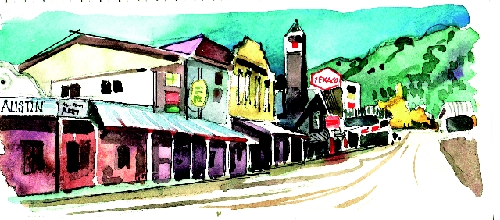Scenic Austin celebrates heritage on July Fourth

Picturesque Austin straddles “The Loneliest Highway in America,” U.S. 50, on a long climb to a mountain pass in Central Nevada. It sits in a spot only a mining town would occupy, the steep slopes of a rugged canyon in the lofty Toiyabe Range. Discovery of rich silver-bearing ore in 1862 reputedly resulted from rocks kicked up by passing Pony Express horses during runs in 1860 and 1861.
Austin lies 326 miles from Las Vegas through landscapes that make up the heart of the Silver State. To reach this lively “ghost town,” drive northwest 209 miles on U.S. Highway 95 to Tonopah. Near downtown watch for the sign for U.S. Highway 6. Turn right and drive 5 miles, then turn left onto State Route 376, which runs to U.S. Highway 60, 100 miles north through the Smokey Valley to U.S. 50. Turn left and drive 12 miles west over two forested summits to reach Austin.
Austin is central to a region that lures visitors seeking roads and trails less traveled. They come to explore the country using paved highways to tour for scenic pleasure and unpaved byways to find the unexpected where only four-wheel drive or off-highway vehicles will do. They arrive geared to hike, mountain bike, backpack, horseback trail ride, camp, fish, hunt, prospect and photograph.
In her heyday, Austin was home to 5,000 people, with at least that many more living in surrounding areas, including isolated ranches and camps near mines in the Reese River Mining District.
In those days Austin was Nevada’s second largest city. The town had its own connection to transcontinental railways with the Nevada Central and a steep little spur from a station at the mouth of Pony Canyon locally dubbed “the Mule’s Relief.” In 1863, Austin became the Lander County seat, a post it held for 116 years until it lost out to Battle Mountain.
The flush years declined after 1887 with a minor revival in the early 1900s and a little excitement over uranium in the 1950s. Today, Austin counts about 340 residents. Small operators still produce a little gold and silver. Locally mined turquoise shows up in Austin’s gem shops, often set in silver from the region.
Much of Austin’s charm emanates from its numerous historical buildings. Cruise the small grid of Austin’s streets to spot vintage structures, many still occupied. The old courthouse still stands but serves different purposes now. The oldest hotel in the Silver State, the International Hotel no longer takes overnight guests but its dining room still serves meals and beverages.
Austin’s venerable church buildings include St. Augustine’s, built in 1866, the last standing of four early Catholic churches in Nevada and now privately owned. The handsome 1866 Methodist Church downtown now houses a community center. Congregations still assemble in the 1878 Episcopal Church, one of the prettiest ever erected in Nevada.
The sturdy single-stone Gridley Store built by R.C. Gridley still occupies a prominent site along the main street in the upper town. Just west of the lower end of town stands Stokes Castle, a three-story stone tower built in 1896 as a summer house by mining and railroad magnate Anson Phelps Stokes. Finished in 1897, lavishly furnished and used just one summer, it stands a forlorn ruin.
Proud of its past, Austin goes all out to celebrate its heritage on the Fourth of July. Events planned July 1-4 include a parade, games and races, a poker run for quads and ATVs, a turkey shoot, a cemetery tour and a race re-enacting a historical event that put Austin in prominence nationwide in 1864.
Store owner R.C. Gridley lost an election bet in 1864 and had to carry a 50 pound bag of flour through the town to the tune of “John Brown’s Body.” The flour sack made the rounds of saloons, where it was auctioned many times, raising $6,000 for the commission caring for Civil War battlefield casualties. Put on tour for auction in many other towns, the Gridley flour sack ultimately raised $275,000.
Visitors for this big weekend often plan to camp in nearby forest service campgrounds or in Austin’s two RV parks totaling 31 spaces. Austin’s three tiny motels have limited numbers of rooms. Two local bed and breakfast inns, the Union Street and the Pony Express have four rooms each. The nearby town of Kingston boasts Miles End with a lodge, three cabins and fine meals.
Margo Bartlett Pesek’s column appears on Sundays.